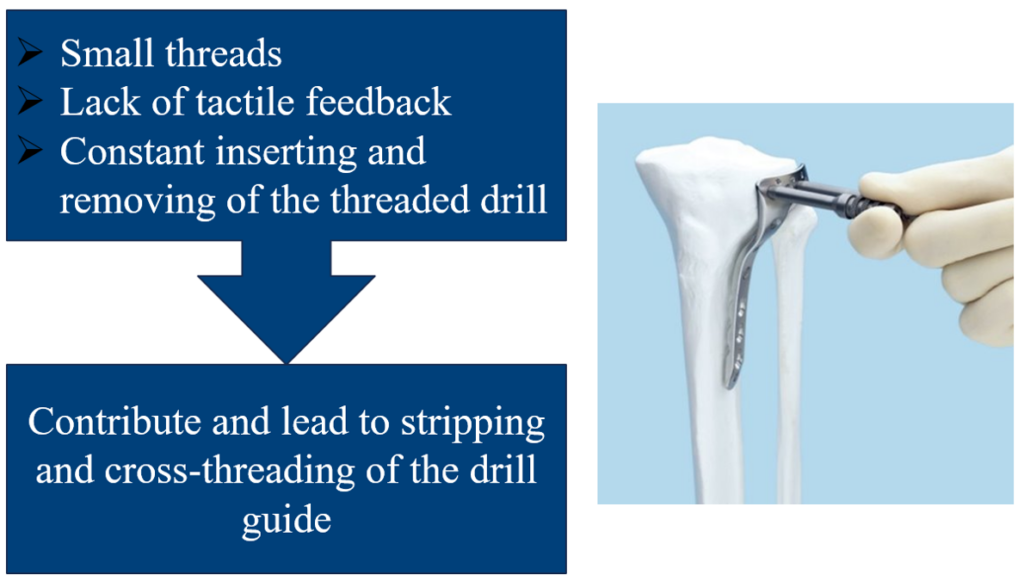
Orthopedic Trauma Surgery Team
Team Members
Background

During our time in the orthopedic trauma operating rooms at Strong Memorial Hospital, our team identified the issue of cross-threading during open reduction, internal fixation (ORIF) procedures. This surgery is required when a fracture cannot be repaired externally, with tools such as a brace or a cast. During these procedures, a locking fracture fixation plate is utilized. These plates feature a threaded hole and a uniquely designed screw that has primary threads that engage with the bone but also threads on the head of the screw which articulate with the threaded hole in the plate. To insert these screws, a threaded drill guide is used, which locks into the threaded hole in the fracture plate so that the clinicians may drill the pilot hole at the correct angle. This drill guide often cross-threads, meaning the threads of the drill guide do not articulate properly with the threads of the hole.

Clinical Problem
Initially, we were primarily invested in solving the issue of cross-threading. However, after
taking a step back, we identified that the problem itself is truly a Human-Factors related issue.
With the current technology, the clinicians do not have the necessary tactile feedback to
recognize that the drill guide is not placed correctly. Additionally, the threads on the drill guides
for the smaller diameter plates (2.4mm and 2.6mm) are extremely small, meaning only a half to
full turn is required to insert it. Lastly, the drill guide has to be constantly inserted and removed
so that each pilot hole can be drilled to insert the locking screws required.

Biodesign Statement
To design a system that simplifies the process of drilling pilot holes and ensures proper alignment of locking screws in ORIF procedures.
Design Methodology
The Sherpa Pro orthopedic device simplifies the process for the insertion of locking screws during ORIF procedures. The device features two components, the guide block and the spring-loaded drill bit. The guide block utilizes registration holes to attach to the fracture fixation plate. The holes on the guide block are designed to be at the predetermined angles of the fracture fixation plate, so that the holes of the guide block and plate are concentric. The pilot holes and locking screws can be inserted without needing remove the guide block, further simplifying the process.
Conclusion
Our testing revealed that the Sherpa Pro was able to drill the required pilot holes under the
critical cross-threading angle. Due to limitations in available materials and time, we have
reached the final stage of prototyping. In the future, we would manufacture the spring-
loaded drill bit and guide block with biocompatible materials, such as surgical-grade stainless
steel. Overall, we have designed a system that eliminates the human-factor-related issues when
inserting locking screws, which as a result eliminates the threat of cross-threading.
In the future, we seek to design a better attachment system for the guide block to the plate. It
would also be beneficial to refine our testing procedures to eliminate noise and sources of error.
Lastly, conducting testing with trained orthopedic residents and clinicians would allow for more
voice of customer feedback and more improved designs.
Acknowledgements
- Dr. Greg Gdowski
- CMTI Executive Director
- Martin Gira
- CMTI Senior Research Engineer
- Mahlett Beyene
- CMTI Graduate Program Coordinator
- Dr. David DiStefano
- Orthopedic Surgeon


